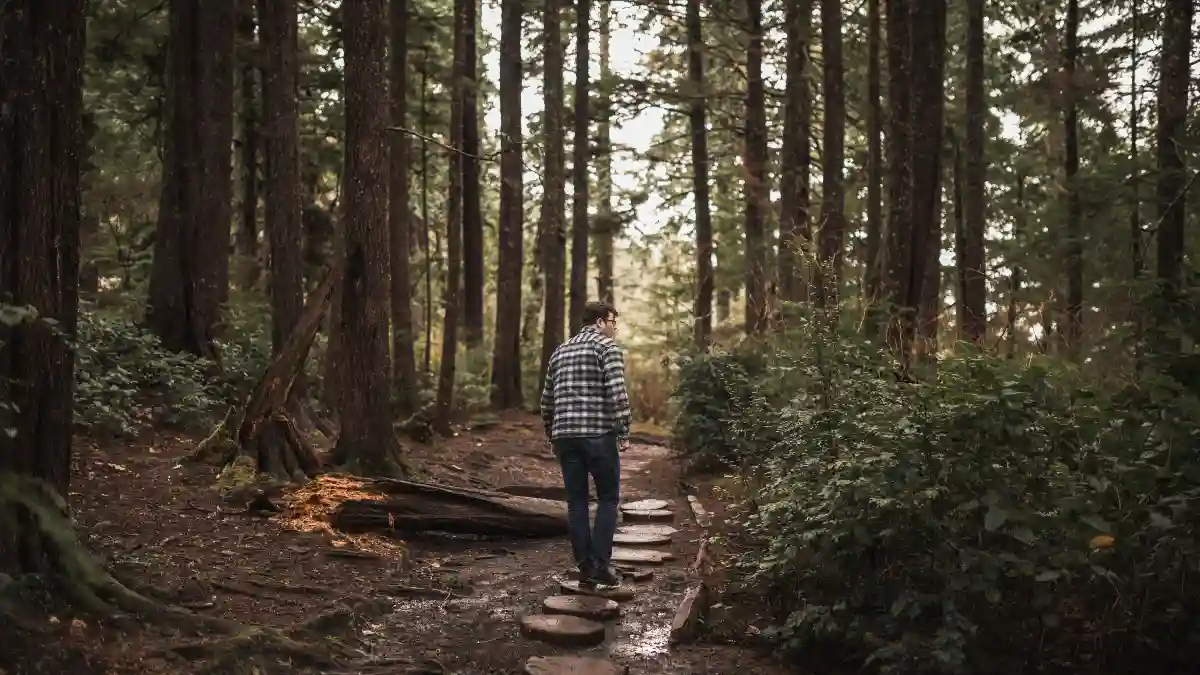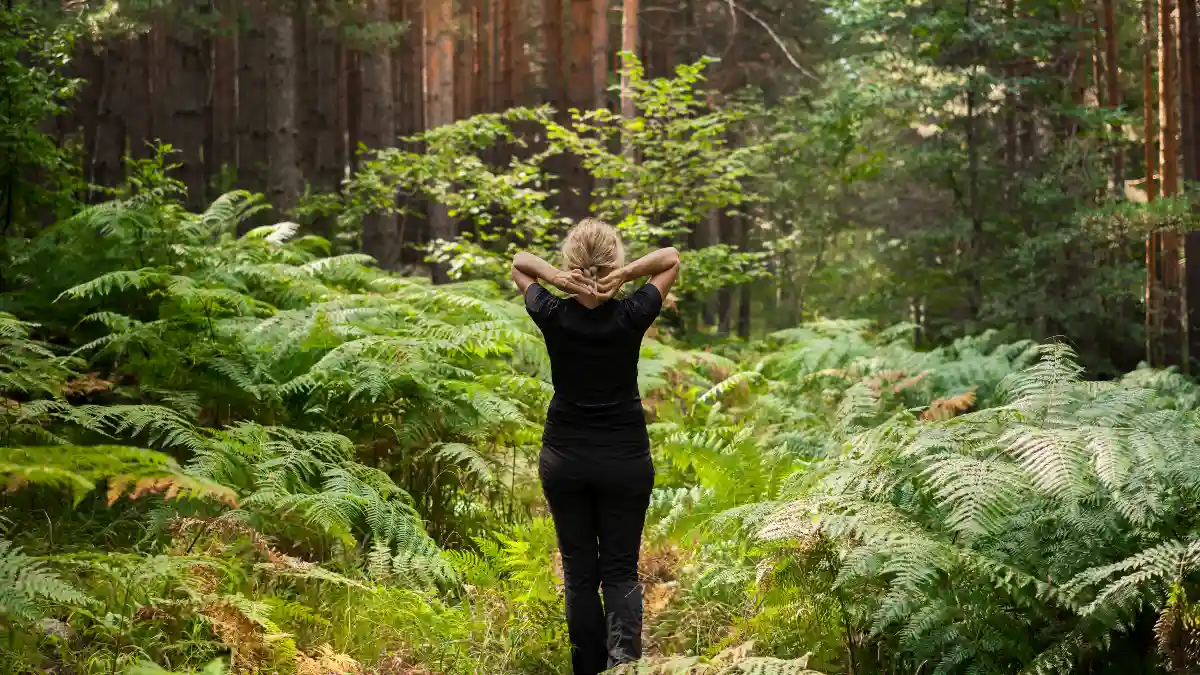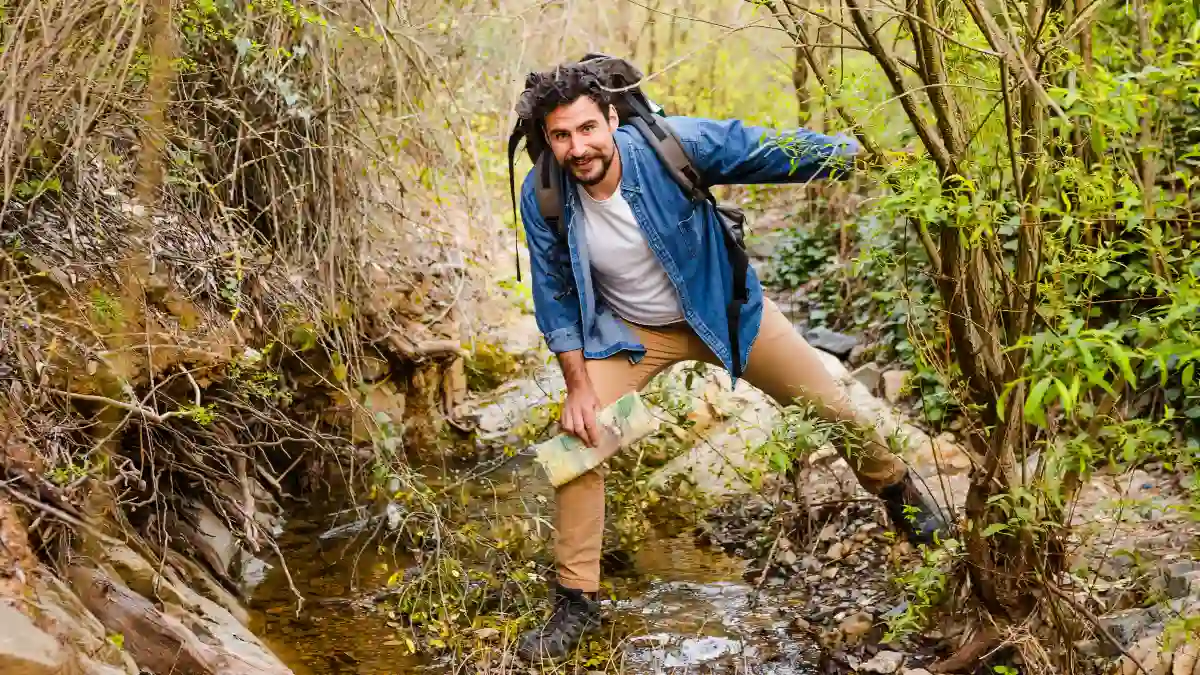A three-day walk in the woods now costs $3,000, and the wellness industry is betting you’re stressed enough to pay for it. This isn’t a joke; it’s the frontline of a booming marketplace.
The global health and wellness industry, set to be worth $6.87 trillion in 2025, has found its most audacious product yet: selling you back the nature that has always been free.
This report digs into the business of commercialized forest bathing. We will show you the real science that proves nature is healing, then expose how that science is twisted to create a costly, questionable market.
You will learn how a simple public health idea became a luxury item and, most importantly, how to get all the benefits yourself without spending a dime. The core question is simple: why is an industry trying so hard to sell you something you already own?
The Ancient Medicine We Forgot — And the Industry That’s Selling It Back to Us

The $6.87 Trillion Question
You’re a professional, dealing with a high-stress job, and you’re feeling burned out. While scrolling on your phone, you see an ad.
It shows calm people in a beautiful forest. The ad promises a “scientifically-proven” way to reset your mind and body. It’s for an exclusive “Forest Bathing Retreat.” The price for a three-day trip? $3,000.
This isn’t a made-up story. It’s a real part of a huge and growing market. The global health and wellness industry is expected to be worth $6.87 trillion in 2025.
A new part of this industry has figured out how to sell something that has always been free: walking in the woods.
This report looks into the business of forest bathing. It’s based on two simple ideas. First, nature really is healing. The science is clear that spending time in a forest is good for your mind and body.
Second, the wellness industry has taken this simple, free practice and turned it into a costly product. They convince you that you need to pay a lot of money to get these benefits.
We will break down how a Japanese health program became a luxury item. We’ll show you how expensive retreats and certifications work. And we’ll give you a guide to get all the benefits of nature without spending a dime.
The real question isn’t if walking in the woods is good for you. It’s why an industry is trying so hard to sell it back to you.
The Real Science of the Woods
Before we look at the business side, it’s important to know that the basic idea is solid. The practice at the center of the industry, called shinrin-yoku in Japan, is not fake science. It is backed by a lot of research that shows real, measurable health benefits.
The name shinrin-yoku means “forest bathing” or “taking in the forest atmosphere.” It was created in 1982 by the Japanese government. The idea is simple: spend mindful time in nature using all your senses. You don’t actually take a bath; you just soak in the environment.
This simple act has powerful effects on your body and mind.
Less Stress, Better Hormones
The biggest selling point of forest bathing is stress relief, and the science backs this up. Your body’s main stress hormone is cortisol.
High levels of it are bad for your health. Studies show that spending time in a forest lowers cortisol levels in your saliva compared to being in a city.
One study found that a walk in the forest lowered cortisol by 12.4% compared to a city walk.8 A review of 22 studies confirmed that forest bathing can significantly lower stress.9 It also calms your nervous system, switching you from “fight or flight” mode to “rest and digest” mode.
A Stronger Heart and Immune System
The benefits also help your heart. Studies show that being in a forest leads to a lower pulse rate and lower blood pressure.
A review of 20 trials in Japan found that blood pressure was much lower in forest settings, which helps prevent heart problems.
Maybe the most amazing finding is about your immune system. Trees release natural compounds called phytoncides to protect themselves from germs. When you breathe these in, it helps your body.
Research by Dr. Qing Li in Japan showed that these phytoncides increase your body’s “Natural Killer” (NK) cells. NK cells are a type of white blood cell that fights tumors and viruses.
One study found that after a three-day forest trip, NK cell activity went up by about 50%. Even better, this boost can last for more than 30 days. This suggests that a forest visit just once a month could help keep your immune system strong.
The mental benefits are just as strong. Using a mood test, studies consistently show that after time in a forest, people feel less anxiety, depression, anger, and tiredness. At the same time, they feel more energy.
This matches what people report about feeling happier and less anxious. Being in nature can also make you smarter. In one study, people who spent three days in nature without technology got 50% better at creative problem-solving.
The science that proves all this was based on simple, short, and unguided time in nature. One key Japanese study had people walk for only 16 minutes and just look at the forest for 14 minutes.
Other research says just 20 minutes outside a day can make you happier. The benefits come from the environment itself—the phytoncides, the oxygen, the sights, and the sounds—not from a special, guided program.
This is the big disconnect. The science used to sell expensive retreats actually proves that a short, free walk in a local park works just as well.
From Public Health Idea to Trillion-Dollar Trend
The story of shinrin-yoku is a perfect example of how a simple idea gets turned into a product. It started as a practical, community-focused plan. In 1982, Tomohide Akiyama of the Japanese government created the term for a national campaign.
At the time, Japan’s tech industry was booming, and so was stress and burnout among city workers.
The shinrin-yoku program was a simple solution. It was meant to improve people’s health and also to encourage them to value the country’s forests for more than just wood.
The idea was new, but it fit with old Japanese traditions from Shinto and Buddhism, which have always seen forests as sacred places.
This simple health idea has since been turned into a business, and it followed a pattern we’ve seen before. The best comparison is what happened to mindfulness. Mindfulness meditation is a 2,500-year-old Buddhist practice for ending suffering.
In the 1970s, it was brought to the West and separated from its religious roots to be used in hospitals. After that, it became a billion-dollar industry with apps like Headspace and Calm.
Critics say this process took away its deep meaning, turning a “Path of Awakening” into a “technique so you can work harder and longer”.
The business of forest bathing is following the same script. It’s a clear industry strategy. First, find an old practice with real, scientific benefits.
Second, remove its original cultural meaning to make it appeal to more people. Shinrin-yoku is no longer about Japanese public health; it’s about personal self-care you can buy. Third, make the simple act sound complicated, so you need to pay “guides” and “instructors” for their special knowledge.
Finally, package it into expensive products like retreats and certifications, making it a luxury good for the wealthy.
What happened to forest bathing isn’t new. It just shows how good the wellness industry is at finding real, free sources of well-being and selling them back to us.
The Anatomy of a $3,000 Walk: Deconstructing the Forest Bathing Scam

The “Wellness Experience” Price Tag
The forest bathing industry has a big problem: the price doesn’t match the service. The benefits of nature are free, but the special “wellness experience” is very expensive.
A look at the market in 2025 shows luxury retreats that cost so much most people can’t afford them. This turns something that belongs to everyone into a product for a select few.
For example, a 4-day “Personal Bespoke Wellness Retreat” in New York starts at $3,995. A “Private Wellness Retreat” in Florida starts at $3,000.
A 3-day stay in a treehouse in Missouri can cost over $1,200. And a 5-day “Nature Reset Retreat” in Japan costs $3,000.
These retreats offer things like “guided forest bathing,” yoga, meditation, and healthy food. These are nice, but you can find them elsewhere for much less money. People have noticed this.
On websites like Reddit, users say they can’t believe people pay for a guided walk. They say “forest bathing” is just a fancy word for a hike.
One person called luxury wellness resorts a “con” for overworked people, saying the real benefit is just taking a break, not the expensive retreat itself.
To see how big the price difference is, let’s compare the options. The table below shows the cost and what you get with different forest bathing choices.
| Offering | Duration | Price (USD) | Price per Day | Core Inclusions |
| Luxury Wellness Retreat (e.g., Dr. Carla’s) | 4 Days / 3 Nights | $3,995+ | $1,331 | Guided walk, yoga, meditation, spa access, all meals. |
| Mid-Range Retreat (e.g., Enchanted Forest) | 3 Days / 2 Nights | ~$1,200 | $600 | Self-guided walk, lodging, optional paid Reiki. |
| Private Guided Walk (Certified Guide) | 2-3 Hours | $175-$300 | N/A | A single guided walk in a public park/forest. |
| Local Conservation Group Walk (e.g., St. Lucie County) | 2 Hours | $0 – $20 | N/A | A guided walk with a naturalist/expert. |
| DIY Forest Bathing | Unlimited | $0 | $0 | Walking in a local park, using a free app/guide. |
Table 1: The Cost of Calm: A Price Comparison of Forest Bathing Offerings (2025). Prices are based on data from sources..
The table makes the point very clear. The main activity—walking in a forest—is the same whether you pay over $1,300 a day or nothing at all.
The high price is justified by adding other services like yoga and meals. But the huge markup makes you ask: what is the “guidance” really worth?
It seems the main thing being sold is not a nature experience, but the idea that well-being is a luxury you have to buy.
How to Become a ‘Forest Expert’ (For a Price)
To charge hundreds of dollars for a walk in the park, the wellness industry needed experts. This led to another profitable business: forest therapy certification.
Many organizations now sell expensive training programs that promise to make you a “Certified Forest Therapy Guide.” This not only creates the “experts” needed to justify high prices but also builds a system that keeps costs high.
Getting certified is expensive. The Association of Nature and Forest Therapy (ANFT) charges $2,995 for a six-month online course.
Then you have to attend a four-day in-person event that costs another $495. That’s almost $3,500, not including a required first-aid course that can cost up to $300.
Other groups charge similar amounts. The Forest Therapy School charges up to $3,700. The Global Institute of Forest Therapy (GIFT) charges $4,250 plus food and lodging , and the International Nature and Forest Therapy Alliance (INFTA) charges $3,800.
These programs teach you how to turn a simple walk into a complex method. You learn about “the language of invitation” and how to “sequence forest therapy invitations for maximum impact”.
This makes the practice seem like a special skill that can be taught and sold, which justifies the guide’s fee.
This certification model works a lot like a multi-level marketing (MLM) scheme. The main business isn’t selling guided walks to the public. It’s selling the “business opportunity” of certification to new guides.
An organization creates a method, and instead of hiring people, it charges them a lot of money to become certified sellers of that method. After spending thousands, these new guides have to charge high prices for their own walks to get their money back.
This creates a cycle where high certification costs lead to high service costs, all for a practice that is free. The ones who benefit most are the organizations at the top selling the certifications.
Why Do People Pay? The Marketing Tricks
Why would someone pay thousands of dollars for a walk in the woods? It’s not just about the money. It’s about smart marketing.
The wellness industry knows how to find our modern worries and sell us expensive solutions. The business of forest bathing uses this strategy perfectly.
The industry’s sales pitch is simple: it points out a problem and sells a solution. It focuses on real issues like stress, screen fatigue, anxiety, and feeling cut off from nature.
Then, it markets expensive retreats as the perfect cure, a special escape from our busy lives. This marketing is very emotional. It doesn’t just sell an activity; it sells the promise of a new you.
Testimonials talk about “deepened connections with self” and feeling “calm, peaceful, present”. The industry is very good at turning ideas like “authenticity” and “well-being” into products you can buy.
The high price is also part of the strategy. By making these experiences expensive, the industry turns wellness into a status symbol.
Going to a $3,000 retreat isn’t just about health; it shows you have the money to invest in yourself. The industry also uses science in a tricky way. It talks about the real research on nature’s benefits but hints that you can only get those benefits through their paid programs. This is misleading.
This whole system is an example of “healthism.” This is a term that describes making health a moral goal and putting all the responsibility on the individual.
The wellness industry treats big problems like burnout from work not as a result of bad work culture, but as your personal failure to do enough “self-care”.
Then, it sells you the “fix” in the form of a retreat, a supplement, or an app. A $3,000 forest bathing retreat is a perfect example.
It tells someone working 80 hours a week that the solution isn’t to fix their job, but to buy a short, expensive escape. This trick shifts the blame for a society-wide problem onto you, the consumer.
Reclaiming the Forest: Your 2025 Guide to Authentic Nature Connection

You Don’t Need a Guide to Walk in the Woods
When you look at the science, the history, and the business, the conclusion is clear: the expensive forest bathing industry is selling something you don’t need. The idea that you need a certified guide and a costly retreat to connect with nature is just not true.
People are starting to speak out. One writer said, “Imagine having to pay someone with a long title to lead you on a walk through the woods!”.
A commentary in a science news outlet said the practice has “become another commodified, self-help-style, precious ‘practice’ of our secular capitalistic culture”. People in online forums agree.
One user called a paid forest bathing event a “pretentious classist thing”. On travel sites, people often say “forest bathing” is just a hike and wonder why anyone would pay for it.
The industry’s main defense is that a guide is needed to “hold a safe space” so you can fully relax.
But this way of thinking makes you a passive customer instead of an active person in charge of your own well-being. It makes you feel like you need the guide, not the forest, to heal.
In fact, paying for a guided walk might actually get in the way of the benefits. The real value of being in nature often comes from being on your own, thinking quietly, and having a direct connection to the world around you.
When you pay for it, you start thinking like a customer. You might worry, “Am I relaxing correctly? Am I getting my money’s worth?”. This kind of thinking is the opposite of being relaxed and in the moment.
The pressure to get value from an expensive retreat can make it impossible to relax. A free, self-guided walk, without any of that pressure, might be a better and more real way to get the benefits of nature.
How to Do Real Forest Bathing for Free
The best way to fight the sale of nature is to empower yourself. If you have the tools and knowledge to practice real forest bathing for free, the expensive options become pointless. This toolkit gives you a simple, practical guide to get back to the forest in 2025.
How to Be Your Own Guide
Real shinrin-yoku is about using your senses, not following a complicated set of rules. You can have a great self-guided session with just a few simple steps:
- Put your phone away: Leave your devices behind or turn them off. The point is to disconnect from the digital world to connect with the natural one.
- Go slow: This is not a workout. Wander without a goal. The Japanese practice is all about meandering.
- Use all your senses: Pay attention to what you see, hear, smell, and touch. Notice the different colors of the leaves. Listen to the birds. Smell the earth. Touch the bark of a tree.
- Breathe: If your mind starts to wander, just focus on your breath. Take ten slow, deep breaths to bring yourself back to the moment.
- Be patient: Stay as long as you feel comfortable. Science shows you can get benefits in just 10-20 minutes, but two hours is often recommended for the full experience.
Digital Tools for an Analog Experience
While the goal is to disconnect, your phone can help you find a place to do it. There are many great, free apps to help you find local parks and trails.
- AllTrails: This is one of the best trail-finding apps, with over 450,000 trails. It has user reviews and offline maps.
- Go Jauntly: This app is made for connecting with nature. It helps you find “green routes” in cities and is great in the UK and Ireland.
- Hiking Project: A free app with detailed trail info, GPS routes, and offline maps.
- Other Apps: For more advanced users, apps like Outdooractive, Gaia GPS, and Komoot offer powerful route planning tools.
Free Guided Experiences
If you still want a guide but don’t want to pay the high prices, there are many alternatives. These are often led by real experts like naturalists and conservationists.
- Local Conservation Groups: Organizations that protect local nature often have free or cheap guided walks. Groups like The Nature Conservancy and local land trusts host walks led by experts.
- County and State Parks: Your local parks department may offer its own nature programs. For example, St. Lucie County in Florida has a calendar of free guided hikes.
- National Organizations: Big non-profits like the Appalachian Mountain Club (AMC) have local chapters that lead hundreds of free or low-cost hikes and workshops.
Resources from Your Couch
If you can’t get outside easily, you can still get some of nature’s benefits. Research shows that even looking at pictures of forests can help you relax.
- Free Audio Guides: You can download free audio guides to use in a park or your backyard. The Tree Council UK and the University of Washington Botanic Gardens offer great free sessions.
- Virtual Forest Bathing: Groups like Forestry England have created videos with forest scenes and sounds to give you a sense of being there from home.
This table puts all these resources in one place.
| Category | Resource Name | Best For | |
| Trail-Finding Apps | AllTrails | The most comprehensive trail database and reviews. | |
| Go Jauntly | Urban “green routes” and nature connection prompts. | ||
| Free Audio Guides | The Tree Council UK | A simple, downloadable guided session. | |
| UW Botanic Gardens | An audio guide and printable handout. | ||
| Find Local Walks | The Nature Conservancy | Finding volunteer events and guided hikes by state. | |
| Appalachian Mountain Club | Finding local chapter outings in the Northeast US. | ||
| DIY Instructions | Forestry England | Beginner tips and a downloadable journal. |


